- Home
- »
- Next Generation Technologies
- »
-
Open Banking Market Size, Share & Trends Report, 2030GVR Report cover
![Open Banking Market Size, Share & Trends Report]()
Open Banking Market Size, Share & Trends Analysis Report By Service, By Deployment (Cloud, On-premise), By Distribution Channel (App Markets, Distributors), By Region, And Segment Forecasts, 2024 - 2030
- Report ID: GVR-4-68039-973-7
- Number of Report Pages: 130
- Format: PDF, Horizon Databook
- Historical Range: 2017 - 2023
- Forecast Period: 2024 - 2030
- Industry: Technology
Open Banking Market Size & Trends
The global open banking market size was estimated at USD 25.14 billion in 2023 and is expected to grow at a CAGR of 27.4% from 2024 to 2030. Open banking allows third-party financial service providers to open access to transactions and other financial data from bank and non-bank financial institutions by using APIs. Access to a wider range of financial services, better experience, and increased control and security of financial data are some of the key benefits of open banking, which are significantly contributing to the market’s growth over the forecast period.
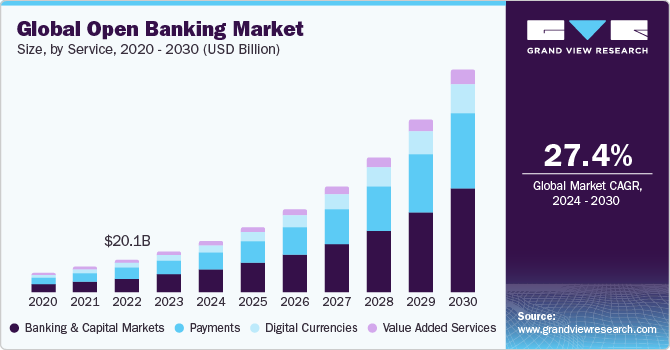
The changing payment ecosystem and the rising adoption of Application Programming Interfaces (APIs) bodes well with the market’s growth. For instance, according to Visa’s Open Banking Consumer Survey conducted in April 2022, around 87% of the consumers in the U.S. are using open banking to link finance accounts with third parties. However, only 34% of these consumers in the U.S. are aware that these services are enabled by open banking. Furthermore, the growing internet penetration and better broadband connectivity are also anticipated to drive the market’s growth over the forecast period.
The rapid digitization and rising adoption of technologies, including artificial intelligence, machine learning, and big data analytics in the industry worldwide are anticipated to drive the growth of the open banking market. Big data analytics is used in the industry to tailor the services and boost the user experience that is anticipated to attract more customers. Furthermore, the improved security of APIs is another major factor fueling the market's growth. In addition, the growing e-commerce and online shopping trends worldwide bode well for the growth of the industry.
The growing adoption of open banking has drawn the attention of venture capital firms, driving investments in the market. For instance, in May 2023, Tarabut Gateway, an open banking platform based in MENA, announced that it raised USD 32 million through a Series A funding round led by Pinnacle Capital. Tarabut Gateway expanded its footprint across the Kingdom of Saudi Arabia market with this funding. Furthermore, the growing strategic initiatives and new product launches by the key companies are also expected to fuel the market's growth over the forecast period.
Although the market is anticipated to grow over the forecast period, it faces challenges such as concerns regarding growing cyber-attacks and online fraud. Open banking encourages the sharing of critical customer information, which raises concerns over data security and privacy protection. However, various firms pursue different strategic initiatives to ensure that critical data is shared securely and consensually. Fintech firms also conform to regulations drafted by various governments worldwide to govern the terms under which consumers grant access to their data.
Market Concentration & Characteristics
The industry growth stage is high, and the pace of the growth is accelerating. Key companies are integrating advanced technologies such as Artificial Intelligence (AI), digital wallets, and blockchain with open banking, making these services more secure while reducing errors and enabling faster transactions.
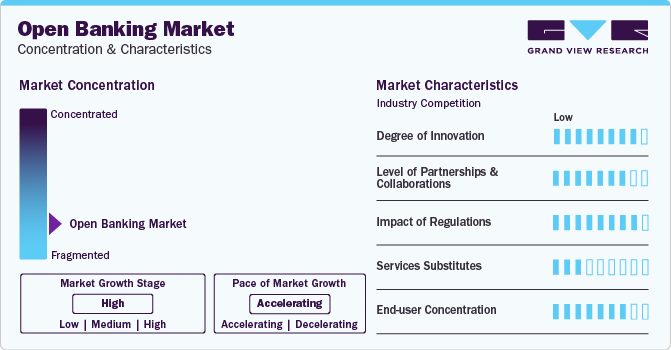
The industry is characterized by a high level of partnerships & collaborations. Key companies are pursuing strategic partnerships & collaborations as a part of their effort to enhance their offerings. These partnerships & collaborations allow businesses to develop efficient solutions and expand their sales across different geographies.
Regulatory considerations have a significant impact on the industry. Regulations such as the Payment Service Directive (PSD2), the Personal Data Protection Act (PDPA), the Consumer Data Right Act (CDR), and the Open API Framework, among many other regulations, play a vital role in shaping the security standards, compliance measures, and operational protocols in the industry.
Traditional banking can be considered an indirect substitute for the industry. However, it cannot match the benefits associated with open banking, such as enhanced customer experience, higher security, and reduced service costs, among others. Hence, service substitutes are low in the industry.
The industry is witnessing high end-user concentration from business end-use. Businesses are using aggregator services as they have more data to process to fulfill their customer’s transactional requirements. Furthermore, businesses are leveraging open banking to offer their customers a better consumer experience and improve retention rates.
Service Insights
The banking & capital markets segment accounted for 45.6% of the global revenue in 2023, thereby leading the market. The growing demand for managing finances effectively among millennials is expected to drive the segment’s growth. Shifting focus from traditional investment methods to advanced investment solutions is expected to generate lucrative opportunities for the segment. The increasing adoption of advanced AI-enabled platforms that can suggest investment options as per customer needs through the integration of algorithms and analytics is expected to propel segment growth.
The payments segment is expected to register the fastest CAGR during the forecast period. The attributes of the growth are increased internet penetration across the world and a surge in the utilization of various platforms for online payments. Such developments occurred as an opportunity for banks to gain a competitive edge and strengthen their market position by collaborating or partnering with such platform providers.
Furthermore, the rise in the launches of payment services by industry players also bodes well for the growth of the segment. For instance, in September 2022, PCI Pal, a financial services company, announced the launch of the Pay By Bank open banking solution for contact centers. As a result of this launch, the company enabled merchants to lower transaction costs and provide instant refunds, along with reduced fraud risk and chargeback costs.
Deployment Insights
The on-premise segment accounted for the largest market revenue share in 2023. It enables easy accessibility for customers, serving their needs better. The segment’s growth is also attributed to BFSI companies offering their APIs, which enable third parties and banks to offer cutting-edge services. In addition, a platform for open banking applications invites users to interact with their financial data in unconventional ways.
The cloud segment is expected to register the fastest CAGR during the forecast period. Cloud deployment service allows banks to collect, analyze, and provide customized services by leveraging an unprecedented amount of consumer data. In addition, cloud technology provides the highest standards of security. Moreover, the cloud enables scalability, flexibility, and real-time processing, which is expected to generate new opportunities for segment growth.
Distribution Channel Insights
The app markets accounted for the largest market revenue share in 2023. The dominance can be attributable to the proliferation of smartphones globally. The growing adoption of mobile applications for buying and selling products and services is expected to drive the segment’s growth. Moreover, rising awareness regarding the utilization of bank-related services through mobile devices also bodes well for the segment’s growth.
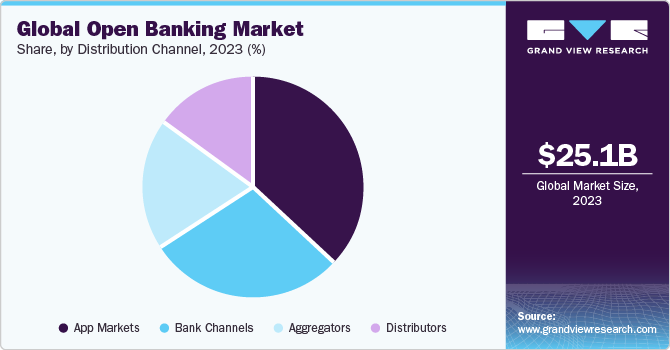
The distributors segment is projected to witness the fastest growth over the forecast period. The growth is ascribed to the fact that in a distributor model, banks function as service or product providers by processing what is eventually sold by a third-party provider. The customer interface is owned by a third-party provider, which is expected to offer unique opportunities for the segment’s growth.
Regional Insights
The open banking market in North America is expected to grow at a significant CAGR of 27.9% from 2024 to 2030. The market is driven by consumer demand for seamless digital experiences, prompting banks to invest in APIs and collaborate with fintech firms to enhance innovation and competitiveness.
U.S. Open Banking Market Trends
The open banking market in the U.S. is expected to grow at a significant CAGR of 27.7% from 2024 to 2030. The market is marked by a surge in fintech adoption, driven by regulatory reforms and consumer demand for personalized financial services, fostering a dynamic ecosystem of banking innovation.
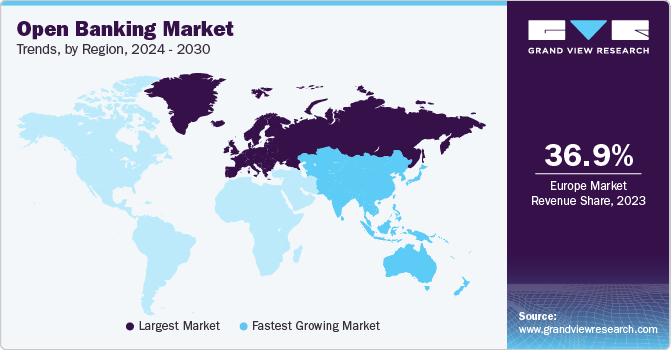
The Canada open banking market is expected to grow at a significant CAGR of 29.1% from 2024 to 2030. The Canadian sector is experiencing growth with regulatory reforms encouraging collaboration between traditional banks and fintech startups, leading to the development of innovative financial solutions and improved customer experiences.
Europe Open Banking Market Trends
Europe dominated the open banking market and accounted for a 36.9% share in 2023. Regional market growth can be ascribed to the increasing need to improve online payment security in the region. Government directives for banks to compel the opening of APIs are promoting market expansion in this region. The presence of numerous prominent companies in the region is further expected to fuel the regional market growth.
The UK open banking market is expected to grow at a significant CAGR of 26.6% from 2024 to 2030. The regional market is characterized by rapid innovation in fintech, supported by regulatory mandates such as PSD2, leading to increased competition and customer-centric financial services.
The open banking market in Germany is expected to grow at a significant CAGR of 26.2% from 2024 to 2030. The landscape of the German market is evolving with a focus on data security and privacy, driving the adoption of digital solutions and fostering collaboration between traditional banks and fintech startups.
Asia Pacific Open Banking Market Trends
The open banking market in Asia Pacific is projected to grow at the fastest CAGR over the forecast period. The regional market growth can be attributed to the growing awareness of the benefits offered by open banking systems among countries such as China, India, and Japan. According to India’s Ministry of Finance, the UPI transaction volume surged from USD 920 million to USD 83.75 billion from 2018 to 2023. This rapid development of digital payment services in Asia Pacific countries is also expected to contribute significantly to the growth of the regional market.
The open banking market in China is expected to grow at a significant CAGR of 26.8% from 2024 to 2030. The Chinese market is propelled by tech giants offering comprehensive financial ecosystems, integrating banking services with e-commerce, payments, and wealth management, reshaping the financial landscape.
The India open banking market is expected to grow at a significant CAGR of 31.5% from 2024 to 2030. The growth of the regional market can be attributed to government initiatives such as the Unified Payments Interface (UPI), growing fintech innovation, and the growing accessibility to financial services for underserved populations.
The open banking market in Japan is expected to grow at a significant CAGR of 27.5% from 2024 to 2030. The regional market is gaining traction with regulatory reforms promoting interoperability, fostering a wave of partnerships between banks and fintech firms to deliver innovative financial products and services.
MEA Open Banking Market Trends
The open banking market in MEA is expected to grow at a significant CAGR of 28.1% from 2024 to 2030. In the MEA region, the market is emerging in countries such as the Kingdom of Saudi Arabia owing to the regulatory frameworks encouraging banks to adopt open APIs, facilitating partnerships with fintech startups, and enhancing competition in the financial sector.
The open banking market in the Kingdom of Saudi Arabia (KSA) is expected to grow at a significant CAGR of 29.1% from 2024 to 2030. The Kingdom of Saudi Arabia is backed by regulatory initiatives such as The Saudi Arabia Open Banking Framework, which includes a set of legislation, regulatory guidelines, and technical standards to enable the development of these services in the KSA.
Key Open Banking Company Insights
Some of the key companies operating in the market include Banco Bilbao Vizcaya Argentaria, S.A., Crédit Agricole, Finastra, NCR Corporation, and Jack Henry & Associates, Inc.
-
Banco Bilbao Vizcaya Argentaria, S.A. provides financial and commercial banking services. Solutions offered by the company include treasury management, regulatory APIs, and a digital ecosystem. The company offers its API and open banking solutions through its BBVA API_Market. The company was recognized as the most innovative bank in 2020 and one of the pioneers in its commitment to APIs and open banking.
-
Finastra is a financial software solution company offering a range of digital banking services, such as knowledge services, support services, client advisory services, managed services, and collaborative design engagement, implementation, and delivery. The company’s solutions for open banking include digital banking, U.S. digital & retail banking, and international digital & retail banking.
DemystData, Ltd., Qwist, FormFree Holdings Corporation, Mambu, and MineralTree, Inc. are some of the emerging companies in the open banking market.
-
Qwist offers seamless solutions for risk mitigation and business expansion through intelligent automation and is regulated under the Payment Services Supervision Act.
-
Mambu provides a cloud-native, SaaS, API-driven financial services platform designed to develop solutions to market faster and to power financial innovation. The platform provides flexible and innovative banking architectures for addressing market opportunities affordably and flexibly, thereby allowing microfinance institutions and other financial entrepreneurs to deliver services to individuals easily and conveniently.
Key Open Banking Companies:
The following are the leading companies in the open banking market. These companies collectively hold the largest market share and dictate industry trends.
- Banco Bilbao Vizcaya Argentaria, S.A.
- Crédit Agricole
- DemystData, Ltd.
- Qwist
- Finastra
- FormFree Holdings Corporation
- Jack Henry & Associates, Inc.
- Mambu
- MineralTree, Inc.
- NCR Corporation
Recent Developments
-
In September 2023, Saxo Bank announced its partnership with Mastercard to integrate open banking payments into Saxo Bank’s investment platforms. Saxo Bank customers can seamlessly transfer money into their investment accounts without having to log in to a separate bank account to transfer funds into their investment accounts.
-
In September 2023, BNY Mellon announced the launch of its open banking payments solution, Bankify. The solution aims to assist organizations in receiving payments from consumer’s bank accounts and offers them guaranteed funds for business receivables.
-
In March 2023, Payer Financial Services AB (publ), a developer of a business-to-business payment platform, introduced B2B open banking payments in Sweden. The company, via open banking APIs, assisted businesses in capturing payments with complete reconciliation and settlement, providing merchants with complete visibility of the payment status in real time.
Open Banking Market Report Scope
Report Attribute
Details
Market size value in 2024
USD 31.61 billion
Revenue forecast in 2030
USD 135.17 billion
Growth rate
CAGR of 27.4% from 2024 to 2030
Actual data
2017 - 2023
Forecast period
2024 - 2030
Quantitative units
Revenue in USD million/billion and CAGR from 2024 to 2030
Report coverage
Revenue forecast, company market share, competitive landscape, growth factors, and trends
Segments covered
Service, deployment, distribution channel, region
Regional scope
North America; Europe; Asia Pacific; Latin America; MEA
Country scope
U.S.; Canada; Germany; UK ; France; China; India; Japan; South Korea; Australia; Brazil; Mexico; The Kingdom Of Saudi Arabia (KSA) ; Kingdom of Bahrain; South Africa
Key companies profiled
Banco Bilbao Vizcaya Argentaria, S.A.; Crédit Agricole; DemystData, Ltd.; Qwist; Finastra; FormFree Holdings Corporation; Jack Henry & Associates, Inc.; Mambu.; Mineral Tree, Inc.; NCR Corporation
Customization scope
Free report customization (equivalent to up to 8 analysts' working days) with purchase. Addition or alteration to country, regional & segment scope
Pricing and purchase options
Avail customized purchase options to meet your exact research needs. Explore purchase options
Global Open Banking Market Report Segmentation
The report forecasts revenue growth at global, regional, and country levels and provides an analysis of the latest industry trends in each of the sub-segments from 2017 to 2030. For this study, Grand View Research has segmented the open banking market report based on service, deployment, distribution channel, and region:
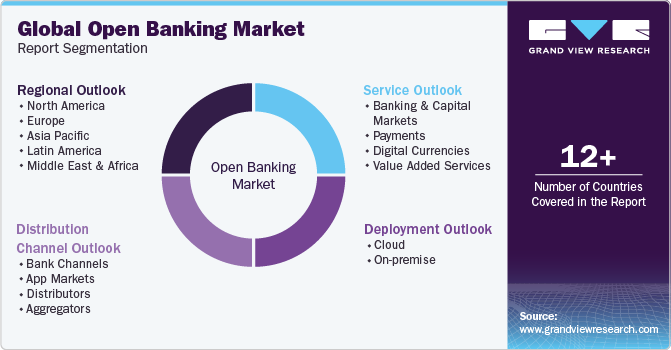
-
Service Outlook (Revenue, USD Billion, 2017 - 2030)
-
Banking & Capital Markets
-
Payments
-
Digital Currencies
-
Value Added Services
-
-
Deployment Outlook (Revenue, USD Billion, 2017 - 2030)
-
Cloud
-
On-premise
-
-
Distribution Channel Outlook (Revenue, USD Billion, 2017 - 2030)
-
Bank Channels
-
App Markets
-
Distributors
-
Aggregators
-
-
Regional Outlook (Revenue, USD Billion, 2017 - 2030)
-
North America
-
U.S.
-
Canada
-
-
Europe
-
Germany
-
UK
-
France
-
-
Asia Pacific
-
China
-
India
-
Japan
-
South Korea
-
Australia
-
-
Latin America
-
Brazil
-
Mexico
-
-
Middle East & Africa
-
Kingdom of Saudi Arabia (KSA)
-
Kingdom of Bahrain
-
South Africa
-
-
Frequently Asked Questions About This Report
b. The global open banking market is expected to grow at a compound annual growth rate of 27.4% from 2024 to 2030 to reach USD 135.17 billion by 2030.
b. Europe dominated the open banking market with a share of 36.93% in 2023. The regional market growth can be ascribed to the increasing requirement for improving online payment security in the region.
b. Some key players operating in the open banking market include Banco Bilbao Vizcaya Argentaria, S.A., Crédit Agricole; DemystData, Ltd.; finleap connect; Finastra; FormFree Holdings Corporation; Jack Henry & Associates, Inc.; Mambu.; Mineral Tree, Inc.; and NCR Corporation.
b. Key factors that are driving the open banking systems market growth include the integration of big data analytics and AI into banking systems and the adoption of digitalization.
b. The global open banking market size was estimated at USD 25.14 billion in 2023 and is expected to reach USD 31.61 billion in 2024.
Share this report with your colleague or friend.
![gvr icn]()
NEED A CUSTOM REPORT?
We can customize every report - free of charge - including purchasing stand-alone sections or country-level reports, as well as offer affordable discounts for start-ups & universities. Contact us now
![Certified Icon]()
We are GDPR and CCPA compliant! Your transaction & personal information is safe and secure. For more details, please read our privacy policy.
We are committed towards customer satisfaction, and quality service.
"The quality of research they have done for us has been excellent."





